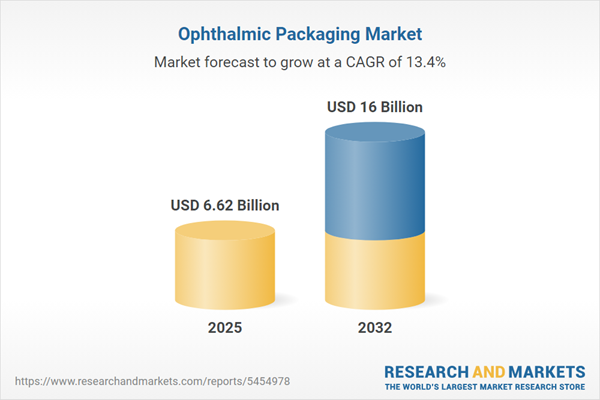Speak directly to the analyst to clarify any post sales queries you may have.
The ophthalmic packaging market is evolving rapidly, shaped by ongoing regulatory changes, an industry-wide focus on safety, and growing expectations for innovative, operationally efficient solutions. Senior leaders are increasingly prioritizing compliance and supply assurance amid shifting market dynamics.
Ophthalmic Packaging Market Snapshot
The ophthalmic packaging market is experiencing steady and noteworthy expansion, with market growth supported by tighter global requirements for drug stability, sterility, and integrity. Pharmaceutical organizations are advancing toward state-of-the-art packaging technologies that align with current regulatory demands and streamline production. The market benefits from the introduction of new drug delivery systems and more intuitive labeling solutions, which increase access and decrease risk of improper use. Focus on tamper-evidence and adaptable supply chains is propelling manufacturers to install systems capable of responding swiftly to emerging conditions. Differentiation in this space comes from the ability to seamlessly integrate compliance and technological advancements, which helps build trust with clinical stakeholders and patients.
Scope & Segmentation of the Ophthalmic Packaging Market
This comprehensive report equips procurement leaders and executive teams with a strategic overview of the ophthalmic packaging market, focusing on sourcing optimization, innovation drivers, and regulatory developments. Segmentation offers a clear framework to evaluate partnership and investment opportunities, as well as operational risks:
- Packaging Types: Ampoules, blisters, bottles, eye drop dispensers, prefilled syringes, tubes, and vials are engineered to work with delicate ophthalmic drugs.
- Material Types: Glass (Types I–III), HDPE, LDPE, PET, and various semisynthetic plastics contribute to drug stability and shelf life management.
- Key Technologies: Blow-fill-seal, fill-finish processes, and prefilled mechanisms each support consistent product quality and scalable production.
- Drug Classes: Includes anesthetics, anti-glaucoma agents, anti-infectives, anti-inflammatories, and ocular lubricants for targeted therapeutic delivery.
- Sterility Approaches: Advanced aseptic techniques and terminal sterilization protocols provide risk mitigation against contamination during the supply journey.
- End-User Channels: Tailored solutions address the operational realities of hospitals, clinics, home care settings, and retail pharmacies, supporting agile distribution networks.
- Applications: Diagnostic, surgical, and therapeutic packaging formats address the broad needs of modern ophthalmic care, from point-of-care testing to specialty procedures.
- Regional Focus: Covers regulatory frameworks and logistics drivers across the Americas, EMEA, and Asia-Pacific, helping clarify risk and define competitive advantages globally.
- Key Industry Players: Bormioli Pharma, Amcor PLC, Weiler Engineering, SCHOTT AG, Corning Incorporated, Nipro Corporation, Bora Pharmaceuticals, West Pharmaceutical Services, NextPharma, and Berry Global Group lead advancements in this arena.
Key Takeaways for Senior Decision-Makers
- Digital traceability solutions and innovative new materials are strengthening risk management and supporting consistent supply in evolving regulatory environments.
- Partnerships between manufacturers and packaging specialists are resulting in adaptive solutions that address modern patient care requirements and facilitate intuitive handling.
- Technologies supporting serialization and tamper evidence are streamlining regulatory processes and increasing product authentication across distribution networks.
- Consolidation in the market is refining competitive strategies, with larger firms delivering operational efficiencies and niche players driving precision solutions for specialized needs.
- Uptake of eco-friendly packaging materials is accelerating, reflecting heightened environmental requirements and broader stakeholder demands throughout the ophthalmic supply ecosystem.
Tariff Impact and Supply Chain Adaptation
Recent changes in U.S. trade regulation are impacting the ophthalmic packaging market, prompting a strategic reassessment of sourcing and logistics. Prioritizing domestic and regional suppliers is now central to protecting supply chain stability and reducing exposure to regulatory volatility. Industry leaders are responding by strengthening resilience and safeguarding access to critical packaging resources, ensuring secure product availability.
Methodology & Data Sources
This report applies a triangulated research methodology, combining in-depth expert interviews with analysis of peer-reviewed literature, regulatory reviews, and validation using commercial datasets. The approach ensures senior teams receive trustworthy, operationally relevant guidance for decision-making on ophthalmic packaging.
Why This Ophthalmic Packaging Market Report Matters
- Enables executive leadership to align procurement strategy and compliance policy with rapidly advancing ophthalmic packaging technologies and regulatory benchmarks.
- Prepares organizations to anticipate and effectively navigate shifting regulatory and market forces, supporting successful differentiation and secure growth.
- Delivers actionable insights into regional manufacturing dynamics and key supply chain developments specific to senior procurement and risk management roles.
Conclusion
This market report provides senior leaders with the insight to refine regulatory strategies, deploy cutting-edge packaging technologies, and remain agile within a competitive and changing landscape. It supports informed planning amid evolving compliance and operational requirements.
Additional Product Information:
- Purchase of this report includes 1 year online access with quarterly updates.
- This report can be updated on request. Please contact our Customer Experience team using the Ask a Question widget on our website.
Table of Contents
3. Executive Summary
4. Market Overview
7. Cumulative Impact of Artificial Intelligence 2025
List of Figures
Companies Mentioned
The companies profiled in this Ophthalmic Packaging market report include:- Bormioli Pharma S.p.A.
- Amcor PLC
- Weiler Engineering, Inc.
- SCHOTT AG
- Corning Incorporated
- Nipro Corporation
- Bora Pharmaceuticals
- West Pharmaceutical Services, Inc.
- NextPharma GmbH
- Berry Global Group, Inc.
Table Information
| Report Attribute | Details |
|---|---|
| No. of Pages | 196 |
| Published | November 2025 |
| Forecast Period | 2025 - 2032 |
| Estimated Market Value ( USD | $ 6.62 Billion |
| Forecasted Market Value ( USD | $ 16 Billion |
| Compound Annual Growth Rate | 13.4% |
| Regions Covered | Global |
| No. of Companies Mentioned | 11 |









